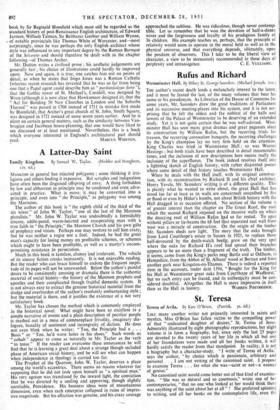Rufus and Richard
Westminster Hall. By Hilary St. George Saunders. (Michael Joseph. 2 ISO THE author's recent death lends a melancholy interest to the latest, and it must be feared the last, of the many volumes that bear his name or his pseudonym. As Librarian of the House of Commons for some years, Mr. Saunders drew the great traditions of Parliament and its successive meeting-places into his system, and it is not sur- prising that he felt the oldest and the noblest Of the halls and towers of the Palace of Westminster to be deserving of an extended study. Yet it is not quite certain that he was well-advised. West- minster Hall has seen many great dramas and great pageants since its construction by William Rufus, but the recurring trials for _treason, the recurring coronation banquets, the recurring challenges by the King's champion lay no very firm hold on the attention. King Charles was tried in Westminster Hall ; so was Warren Hastings ; but both trials have been described in detail innumerable times, and the inclusion of new descriptions here means really the inclusion of the superfluous. The book indeed resolves itself into a lightning sketch of English history, with rather disjointed pauses where some detail of that history touches Westminster Hall.
When he deals with the Hall itself, with its original construc- tion, with its reconstruction by Richard II and his chief architect, Henry Yevele, Mr. Saunders' writing is of a different quality. This is plainly what he wanted to write about, the great Hall. that has stood (so far at least as its walls are concerned) unscathed by fire or flood or even by Hitler's bombs, not about British history with the Hall dragged in as occasion offered. No section of the volume is of greater interest than the chapter on The Great Roof, the roof which the second Richard imposed on the massive walls on which the decaying roof of William Rufus had so far rested. To span withoiit pillars or tie-beams the 68 feet that separated east wall from west was a miracle of construction. On the origin of the timber Mr. Saunders sheds new light. The story that the oaks brought from Lord Courthope's estate in Sussex in 1921, to replace those half-devoured by the death-watch beetic, grew on the very spot where the oaks for Richard II's roof had spread their branches appears to be no more than a fragment of the truth. The timber, it seems, came from the King's parks near Battle and at Odiham, in Hampshire, from the Abbot of St. Albans' wood at Bernan and from another park near Kingston-on-Thames. There is indeed a reported item in the accounts, under date 1394, "Bought for the King for his Hall at Westminster great oaks from Courthope of Wadhurst," but no such entry can be traced, and its authegicity must be con- sidered doubtful. Altogether the Hall is more impressive in itself






























 Previous page
Previous page